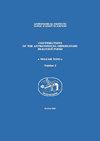Photometric and period analysis of the eclipsing binary system V2783 Ori
IF 0.2
4区 物理与天体物理
Q4 ASTRONOMY & ASTROPHYSICS
Contributions of the Astronomical Observatory Skalnate Pleso
Pub Date : 2021-06-01
DOI:10.31577/CAOSP.2021.51.2.163
引用次数: 0
Abstract
. In this study we performed the first detailed photometric and period analysis of the recently discovered eclipsing binary star V2783 Ori. The analysis of the light curve has shown that the system is in a detached configuration, with the orbital eccentricity e = 0.274 ± 0.008. The photometric mass ratio of V2783 Ori determined from the light curve analysis is q = 0.734 ± 0.015. The absolute parameters of the system were obtained as a result of the light curve solution. Absolute parameters were found as follows: masses M 1 = 1.80 ± 0.01 M (cid:12) , M 2 = 1.32 ± 0.01 M (cid:12) , radii R 1 = 2.19 ± 0.10 R (cid:12) , R 2 = 1.91 ± 0.10 R (cid:12) , temperatures T 1 = 8325 ± 100 K and T 2 = 8300 ± 100 K. A comparison of these parameters with theoretical stellar models show that the secondary component is located inside the main-sequence band and still close to ZAMS, while the primary component is located in the middle of ZAMS-TAMS limits. The distance of the system determined from the absolute parameters, d = 1064 ± 150 pc, takes into account the interstellar reddening. The (O–C) diagram was discussed considering all reliable minima times found in the literature and new values for the parameters of the apsidal motion and light-time effect were found. The apsidal motion rate of V2783 Ori is ˙ ω = 0.0063 ± 0.0017 deg cycle − 1 , and it corresponds to an apsidal motion period of U = 656 ± 103 yr. The third body orbital period is 10 ± 2 yr, its minimal mass is 0.82 ± 0.11 M (cid:12) .食双星系统V2783-Ori的光度和周期分析
. 在这项研究中,我们对最近发现的双星猎户座V2783进行了首次详细的光度和周期分析。光曲线分析表明,该系统处于分离构型,轨道偏心率e = 0.274±0.008。通过光曲线分析得到V2783 Ori的光度质量比为q = 0.734±0.015。通过光曲线求解得到了系统的绝对参数。得到的绝对参数如下:质量m1 = 1.80±0.01 M (cid:12), m2 = 1.32±0.01 M (cid:12),半径r1 = 2.19±0.10 R (cid:12), r2 = 1.91±0.10 R (cid:12),温度t1 = 8325±100 K, t2 = 8300±100 K。这些参数与理论恒星模型的比较表明,次级分量位于主层序带内,仍然接近ZAMS,而主分量位于ZAMS- tams极限的中间。系统的距离由绝对参数d = 1064±150pc确定,考虑了星际变红。对(O-C)图进行了讨论,考虑了文献中发现的所有可靠的最小时间,并找到了附加运动和光时效应参数的新值。V2783 Ori的附加运动速率为˙ω = 0.0063±0.0017 deg cycle−1,对应的附加运动周期为U = 656±103 yr,第三个天体的轨道周期为10±2 yr,最小质量为0.82±0.11 M (cid:12)。
本文章由计算机程序翻译,如有差异,请以英文原文为准。
求助全文
约1分钟内获得全文
求助全文
来源期刊
CiteScore
1.10
自引率
20.00%
发文量
4
审稿时长
>12 weeks
期刊介绍:
Contributions of the Astronomical Observatory Skalnate Pleso" (CAOSP) is published by the Astronomical Institute of the Slovak Academy of Sciences (SAS). The journal publishes new results of astronomical and astrophysical research, preferentially covering the fields of Interplanetary Matter, Stellar Astrophysics and Solar Physics. We publish regular papers, expert comments and review contributions.

 求助内容:
求助内容: 应助结果提醒方式:
应助结果提醒方式:


